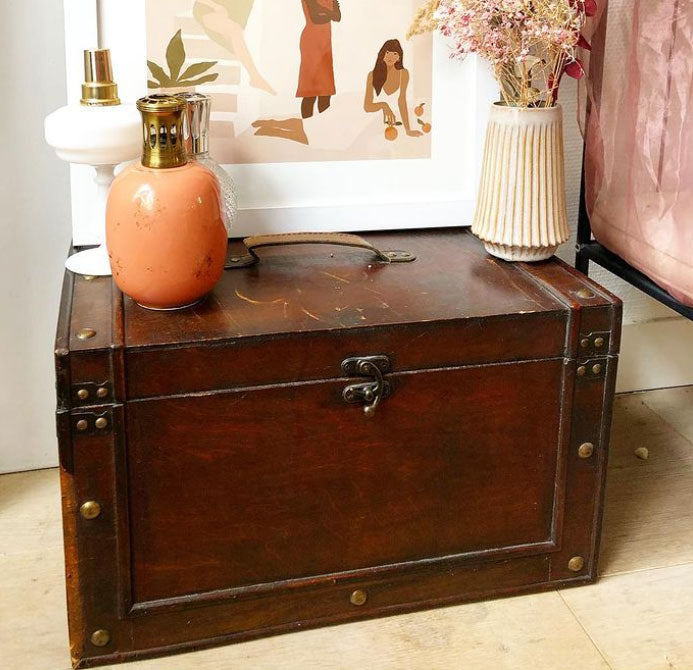Entre la déco vintage et le geste éco-responsable, la récupération d’objets dans les rues permet de se remeubler sans se ruiner et en toute bonne conscience ! Avant de vous lancer, suivez le guide !
Il y a quelques années, une de mes stagiaires de retour de New York, me racontait comment, sans le sou, elle avait entièrement décoré son appartement en récupérant des meubles (canapé, table, lit…) dans la rue. J’avais trouvé cette idée très étrange, mais elle m’avait rassurée en me disant que c’était très fréquent aux États-Unis. J’ai sans doute gardé cette information dans le coin de ma tête, car depuis, je regarde les encombrants laissés dans la rue d’une autre façon.
Ouvrez l’œil
Au détour d’une rue, à pied ou en voiture, on peut tomber à tout moment sur un petit trésor abandonné par son propriétaire. La raison ? Un changement de déco, un déménagement, un tri. Imaginez … la ville de Paris récupère chaque année près de 90 000 tonnes d’objets encombrants. D’après le journal Le Monde : 43 000 canapés, 930 cuisinières, 4600 lave-vaisselles. Sans oublier les montagnes de petits objets (vaisselle en tout genre, livres, coussins, plantes…). Se mettre à la récup’, ce n’est pas faire les poubelles, c’est juste ouvrir l’œil sur les objets laissés sur les trottoirs et qui peuvent encore servir.
Surveillez les encombrants
La première chose à faire est de se renseigner sur les dates de passage des encombrants. Dans certaines villes, la date est fixe (dernier jeudi du mois, chaque lundi, etc.) dans d’autres grandes villes (Paris, Lyon, Marseille) c’est un service au cas par cas. Le particulier prend rendez-vous et dépose son objet devant chez lui en fonction. Quand le jour est fixe, il suffit de se promener dans les rues la veille au soir. Dans l’autre cas, c’est au petit bonheur la chance. Sachez que certaines rues sont plus « donneuses » que d’autres. En effet, certains habitants, qui doivent sans doute trier régulièrement, mettent proprement à disposition, dans des sacs, des objets pour les intéressés. Une fois un « spot » trouvé, il suffit de passer devant un peu plus souvent que d’habitude. Sachez aussi qu’il y a des jours plus propices à la récup’ : le dimanche et le lundi après le tri du week-end, les fins de mois, les mois de déménagement (de mai à septembre) et le mois de janvier après la déferlante des cadeaux.
Soyez créatifs

De nombreux tutos sur YouTube existent sur « comment transformer un meuble » ou « que faire avec une palette en bois ». Si vous n’êtes pas très bricoleur, vous pouvez tout simplement récupérer un objet en excellent état (ça arrive très souvent). Autre possibilité : donner une nouvelle vie à un objet. Par exemple, une chaise haute comme porte plante.
Évitez certains objets
Pas question bien sûr de tout récupérer et de transformer votre chez vous en bric-à-brac de la récup’. Le plus simple est de vous laisser tenter par un objet qui pourrait avoir une utilité chez vous. En cas de doute, passez votre chemin. Avant d’embarquer les objets, vérifiez leur état et détectez la présence de petites piqures sur les meubles, signes de nuisibles. Pour éviter de ramener des puces de lit chez vous, faites l’impasse sur les matelas ou les sommiers !
Nettoyez les petits trésors
Une fois à la maison, nettoyez bien les objets avec une éponge et un matériel dédié. Utilisez aussi un bâton de fumigation (sauge, Palo santo) pour retirer toutes les énergies accumulées et faire place nette.
Suivez les bons comptes




Sur Instagram, de nombreux comptes de particuliers sont entièrement dédiés à la récup’ en ville. Vous allez être bluffés par tout ce qui est trouvé et récupéré dans les rues. Comment équiper entièrement une maison sans jamais rien acheter avec le compte @tombes_du_ciel ou @la_recyclerie_des_merveilles ou @lrecycle_la_rue ou @merci_la_rue_. Le point commun de ces comptes ? Redonner une nouvelle vie aux objets jetés afin de limiter les déchets et d’éviter le cycle infernal de la société de consommation (j’achète, je jette, je remplace). Autres comptes inspirants @consommons.sainement @defi_riendeneuf qui partagent des tutos de récup’ et donnent des astuces pour mieux consommer.
Équipez-vous
Si vous êtes à pied, prenez toujours avec vous un petit sac pliable, des gants (pour inspecter les meubles et autre objet) et ouvrez l’œil… des tonnes de trésors vous attendent !
A lire pour en savoir plus : La récup’facile d’Aline Gubri (Éditions Leduc, 14,90 €).











